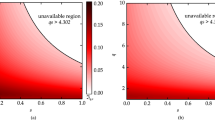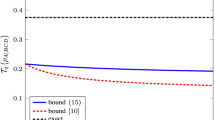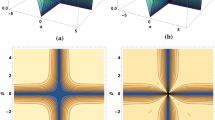Abstract
We study the entanglement of multiqubit fermionic pseudo-Hermitian coherent states (FPHCSs) described by anticommutative Grassmann numbers. We introduce pseudo-Hermitian versions of well-known maximally entangled pure states, such as Bell, GHZ, Werner, and biseparable states, by integrating over the tensor products of FPHCSs with a suitable choice of Grassmannian weight functions. As an illustration, we apply the proposed method to the tensor product of two- and three-qubit pseudo-Hermitian systems. For a quantitative characteristic of entanglement of such states, we use a measure of entanglement determined by the corresponding concurrence function and average entropy.
Similar content being viewed by others
References
M. A. Nielsen and I. L. Chuang, Quantum Computation and Quantum Information, Cambridge Univ. Press, Cambridge (2000).
O. Gühne and G. Tóth, “Entanglement detection,” Phys. Rep., 474, 1–75 (2009).
S. J. van Enk, N. Lütkenhaus, and H. J. Kimble, “Experimental procedures for entanglement verification,” Phys. Rev. A, 75, 052318 (2007).
P. Horodecki, “Measuring quantum entanglement without prior state reconstruction,” Phys. Rev. Lett., 90, 167901 (2003).
P. Horodecki and A. Ekert, “Method for direct detection of quantum entanglement,” Phys. Rev. Lett., 89, 127902 (2002).
S. P. Walborn, P. H. Souto Ribeiro, L. Davidovich, F. Mintert, and A. Buchleitner, “Experimental determination of entanglement with a single measurement,” Nature, 440, 1022–1024 (2006).
C. Schmid, N. Kiesel, W. Wieczorek, and H. Weinfurter, “Experimental direct observation of mixed state entanglement,” Phys. Rev. Lett., 101, 260505 (2008).
G. Vidal, “Entanglement monotones,” J. Modern Opt., 47, 355–376 (2000).
J. S. Bell, Speakable and Unspeakable in Quantum Mechanics, Cambridge Univ. Press, Cambridge (1987).
S. Lloyd and S. L. Braunstein, “Quantum computation over continuous variables,” Phys. Rev. Lett., 82, 1784–1787 (1999).
S. J. van Enk, “Decoherence of multidimensional entangled coherent states,” Phys. Rev. A, 72, 022308 (2005).
S. J. van Enk and O. Hirota, “Entangled coherent states: Teleportation and decoherence,” Phys. Rev. A, 64, 022313 (2001).
H. Fu, X. Wang, and A. I. Solomon, “Maximal entanglement of nonorthogonal states: Classification,” Phys. Lett. A, 291, 73–76 (2001).
X. Wang and B. C. Sanders, “Multipartite entangled coherent states,” Phys. Rev. A, 65, 012303 (2002).
X. Wang, “Bipartite entangled non-orthogonal states,” J. Phys. A: Math. Gen., 35, 165–174 (2002).
X. Wang, B. C. Sanders, and S. H. Pan, “Entangled coherent states for systems with SU(2) and SU(1, 1) symmetries,” J. Phys. A: Math. Gen., 33, 7451–7467 (2000).
X. Wang, “Entanglement in the quantum Heisenberg XY model,” Phys. Rev. A, 64, 012313 (2001).
L. Borsten, D. Dahanayake, M. J. Duff, and W. Rubens, “Superqubits,” Phys. Rev. D, 81, 105023 (2010).
F. C. Khanna, J. M. C. Malbouisson, A. E. Santana, and E. S. Santos, “Maximum entanglement in squeezed boson and fermion states,” Phys. Rev. A, 76, 022109 (2007).
G. Najarbashi and Y. Maleki, “Entanglement of Grassmannian coherent states for multi-partite n-level systems,” SIGMA, 7, 011 (2011); arXiv:1008.4836v2 [math-ph] (2010).
G. Najarbashi and Y. Maleki, “Maximal entanglement of two-qubit states constructed by linearly independent coherent states,” Internat. J. Theor. Phys., 50, 2601–2608 (2011).
Y. Maleki, “Para-Grassmannian coherent and squeezed states for pseudo-Hermitian q-oscillator and their entanglement,” SIGMA, 7, 084 (2011); arXiv:1108.5005v1 [math-ph] (2011).
S. Majid, “Random walk and the heat equation on superspace and anyspace,” J. Math. Phys., 35, 3753–3760 (1994).
D. C. Cabra, E. F. Moreno, and A. Tanasă, “Para-Grassmann variables and coherent states,” SIGMA, 2, 087 (2006).
O. Cherbal, M. Drir, M. Maamache, and D. A. Trifonov, “Fermionic coherent states for pseudo-Hermitian two-level systems,” J. Phys. A: Math. Theor., 40, 1835–1844 (2007).
G. Najarbashi, M. A. Fasihi, and H. Fakhri, “Generalized Grassmannian coherent states for pseudo-Hermitian n-level systems,” J. Phys. A: Math. Theor., 43, 325301 (2010).
F. G. Scholtz, H. B. Geyer, and F. J. W. Hahne, “Quasi-Hermitian operators in quantum mechanics and the variational principle,” Ann. Phys., 213, 74–101 (1992).
C. M. Bender and S. Boettcher, “Real spectra in non-Hermitian Hamiltonians having PT symmetry,” Phys. Rev. Lett., 80, 5243–5246 (1998).
C. M. Bender, S. Boettcher, and P. N. Meisenger, “PT-symmetric quantum mechanics,” J. Math. Phys., 40, 2201–2229 (1999).
C. M. Bender and G. V. Dunne, “Large-order perturbation theory for a non-Hermitian PT-symmetric Hamiltonian,” J. Math. Phys., 40, 4616–4621 (1999).
F. Cannata, G. Junker, and J. Trost, “Schrödinger operators with complex potential but real spectrum,” Phys. Lett. A, 246, 219–226 (1998).
M. Znojil, F. Cannata, B. Bagchi, and R. Roychoudhury, “Supersymmetry without Hermiticity within PT symmetric quantum mechanics,” Phys. Lett. B, 483, 284–289 (2000).
A. Mostafazadeh, “Pseudo-Hermiticity versus PT symmetry: The necessary condition for the reality of the spectrum of a non-Hermitian Hamiltonian,” J. Math. Phys., 43, 205–214 (2002).
A. Mostafazadeh, “Pseudo-Hermiticity versus PT-symmetry: II. A complete characterization of non-Hermitian Hamiltonians with a real spectrum,” J. Math. Phys., 43, 2814–2816 (2002).
A. Mostafazadeh, “Pseudo-Hermitian representation of quantum mechanics,” Intenat. J. Geom. Meth. Modern Phys., 7, 1191–1306 (2010).
N. Hatano and D. R. Nelson, “Localization transitions in non-Hermitian quantum mechanics,” Phys. Rev. Lett., 77, 570–573 (1996).
N. Hatano and D. R. Nelson, “Vortex pinning and non-Hermitian quantum mechanics,” Phys. Rev. B, 56, 8651–8673 (1997).
C. H. Bennett, G. Brassard, C. Crepeau, R. Jozsa, A. Peres, and W. K. Wooters, “Teleporting an unknown quantum state via dual classical and Einstein–Podolsky–Rosen channels,” Phys. Rev. Lett., 70, 1895–1899 (1993).
D. Bouwmeester, A. K. Ekert, and A. Zeilinger, eds., The Physics of Quantum Information: Quantum Cryptography, Quantum Teleportation, Quantum Computation, Springer, 2001.
A. K. Pati, “Minimum classical bit for remote preparation and measurement of a qubit,” Phys. Rev. A, 63, 014302 (2001).
A. V. Sergienko, ed., Quantum Communications and Cryptography, CRC Press Taylor and Francis Group, Boca Raton, Fla. (2006).
P. G. O. Anicich and H. Grinberg, “Grassmann coherent states for spin systems,” J. Molec. Struct., 621, 9–18 (2003).
S. Abe, “Adiabatic holonomy and evolution of fermionic coherent state,” Phys. Rev. D, 39, 2327–2331 (1989).
J. Ohnuki and T. Kashiwa, “Coherent states of Fermi operators and the path integral,” Prog. Theor. Phys., 60, 548–564 (1978).
F. A. Berezin, The Method of Second Quantization [in Russian], Fizmatlit, Moscow (1965); English transl., Acad. Press, New York (1966).
K. E. Cahill and R. J. Glauber, “Density operators for fermions,” Phys. Rev. A, 59, 1538–1555 (1999).
A. Acin, D. Bruβ, M. Lewenstein, and A. Sanpera, “Classification of mixed three-qubit states,” Phys. Rev. Lett., 87, 040401 (2001).
A. K. Pati, “Entanglement in non-Hermitian quantum theory,” Pramana, 73, 485–498 (2010).
W. K. Wootters, “Entanglement of formation of an arbitrary state of two qubits,” Phys. Rev. Lett., 80, 2245–2248 (1998).
S. Hill and W. K. Wootters, “Entanglement of a pair of quantum bits,” Phys. Rev. Lett., 78, 5022–5025 (1997).
W. E. Lamb, R. R. Schlicher, and M. O. Scully, “Matter-field interaction in atomic physics and quantum optics,” Phys. Rev. A, 36, 2763–2772 (1987).
J. C. Garrison and E. M. Wright, “Complex geometrical phases for dissipative systems,” Phys. Lett. A, 128, 177–181 (1988).
A. K. Rajagopal and R.W. Rendell, “Nonextensive statistical mechanics: Implications to quantum information,” Europhys. News, 36, 221–224 (2005).
M. B. Plenio and V. Vedral, “Teleportation, entanglement and thermodynamics in the quantum world,” Contemp. Phys., 39, 431–446 (2001).
Author information
Authors and Affiliations
Corresponding author
Additional information
Prepared from an English manuscript submitted by the authors; for the Russian version, see Teoreticheskaya i Matematicheskaya Fizika, Vol. 196, No. 1, pp. 99–116, July, 2018.
Rights and permissions
About this article
Cite this article
Mirzaei, S., Najarbashi, G., Fasihi, M.A. et al. Entanglement of Multipartite Fermionic Coherent States for Pseudo-Hermitian Hamiltonians. Theor Math Phys 196, 1028–1042 (2018). https://doi.org/10.1134/S0040577918070097
Received:
Revised:
Published:
Issue Date:
DOI: https://doi.org/10.1134/S0040577918070097




